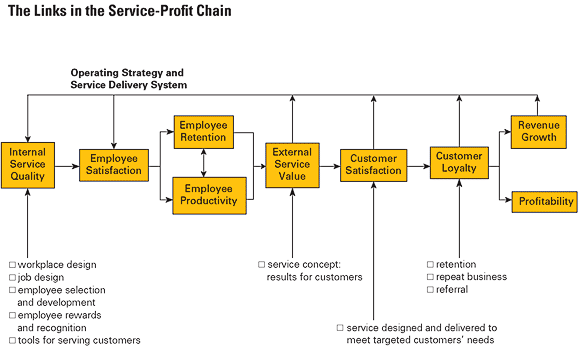In the Infosurv Insider blog about a year ago, we wrote about the Service Profit Chain and how you can benefit:
“The new economics of service requires innovative measurement techniques. These techniques calibrate the impact of employee satisfaction, loyalty, and productivity on the value of products and services delivered so that managers can build customer satisfaction and loyalty and assess the corresponding impact on profitability and growth.”
This quote was taken from an article written in 2008, by James L. Heskett, Thomas O. Jones, Gary W. Loveman, W. Earl Sasser, Jr., and Leonard A. Schlesinger in the July – August 2008 issue of the Harvard Business Review. Even more interesting, the original research on the Service Profit Chain was done in 1994 by the same team and also published in HBR.
The diagram below describes the Service Profit Chain and how each link contributes to profitability:

The topic of the linkage between customers, employees and profitability seems to becoming prominent once again. More recently, V Kumar and Anita Pansari, writing in the MIT Sloan Management Review in Summer 2015 and again in the Journal of Marketing in August 2016, again demonstrated research that confirms the link between employees, customers, and profitability.
While this research was considered ground-breaking in 1994, it is interesting that we are still talking about it. However, even today, few companies are successfully linking the measurement and management of customers, employees, and profit. What is keeping businesses from taking advantage of this proven strategy?
Part of the problem is politics: different parts of the Service-Profit Chain are “owned” by different departments within the business. Customer satisfaction is usually owned by Marketing or Operations, employee engagement is owned by HR, and performance metrics are owned by Finance. Cooperation from multiple departments is typically required to manage the service profit chain.
Additionally, there may be technical issues. Customer satisfaction can be measured over the longer term (annually or less frequently) as relationships metrics or based on each transaction (transactional satisfaction metrics). Employee engagement is usually measured annually. And of course, business performance is measured very frequently – perhaps even daily in some businesses. Interpreting data across different time periods and modalities is challenging at best.
Creating linkages between employees, customers and profitability can be daunting, especially in larger, service-based businesses. However, it does not have to be insurmountable. One of the simpler ways to approach the challenge is to add some customer metrics to the employee survey and add employee metrics to the customer surveys. While this leaves out the important profitability element, at least it is a starting point to understanding and appreciating the linkages in your business that drive profitability.